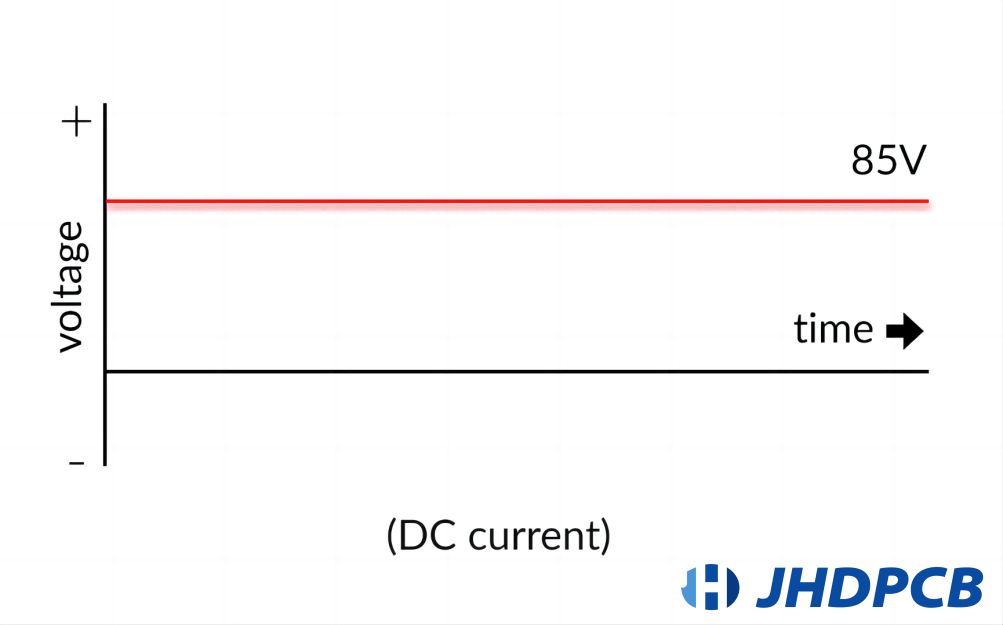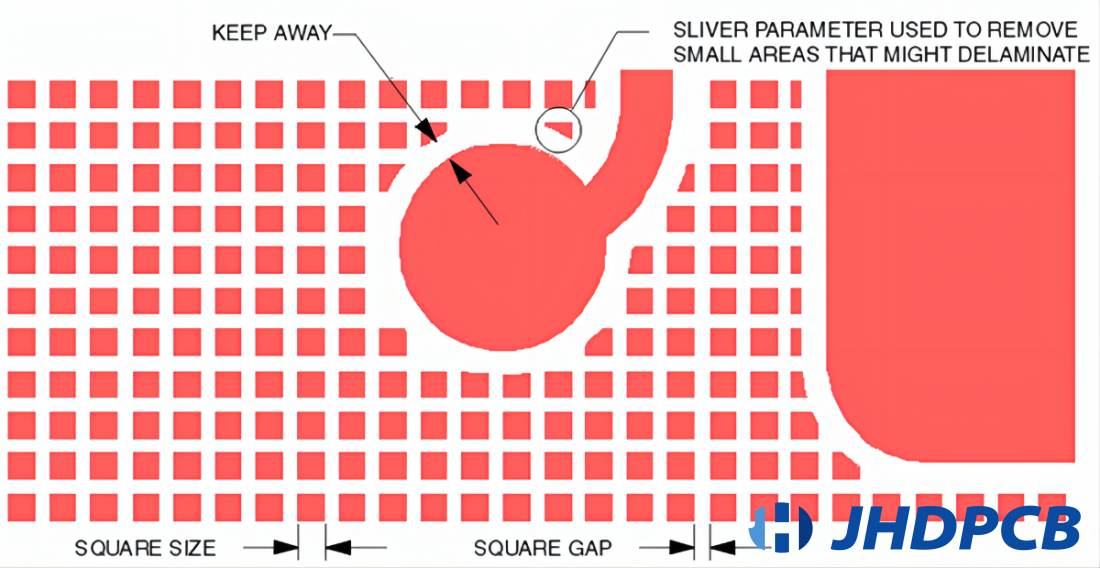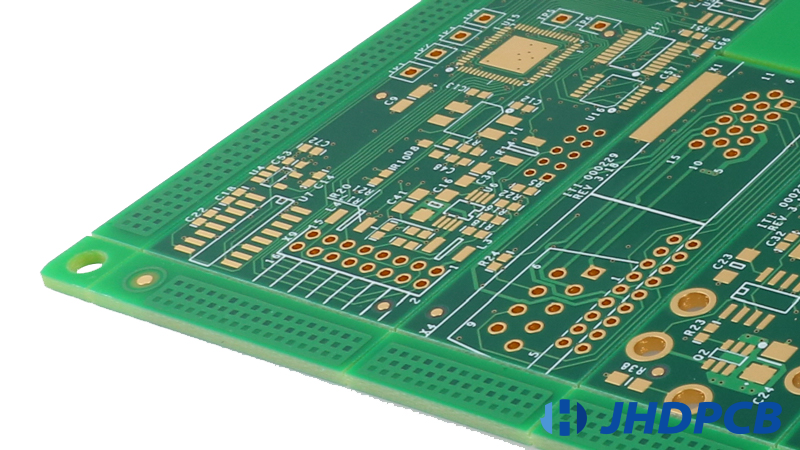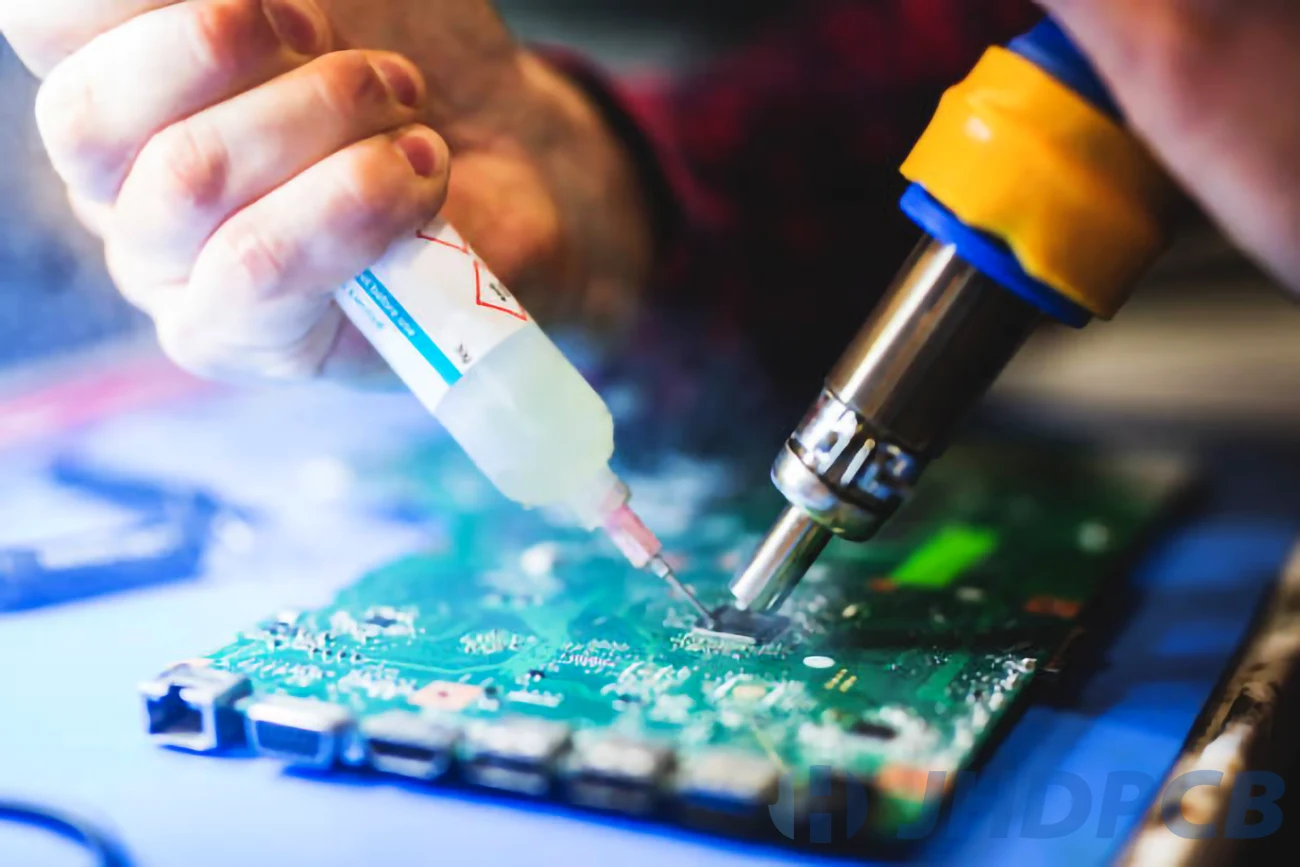Alternating Current vs Direct Current Comprehensive Guide
Welcome to the world of DC circuits! At JHDPCB, we are proud of our expertise in designing, manufacturing, and assembling high-quality PCBs for a wide range of DC applications. Our team of skilled engineers and technicians possess the knowledge and resources to create custom PCB solutions for consumer electronics, automotive systems, industrial machinery, and more. With cutting-edge facilities and stringent quality control, we deliver flawless products that ensure the optimal functioning of DC circuits. Join us on this electrifying adventure as we explore the fundamentals of DC circuits, uncover the workings of key components, and discover how JHDPCB can provide tailored solutions to optimize your designs. Let’s unlock the limitless potential of DC circuits together!
What is DC voltage?
Direct current (DC) refers to the unidirectional movement of electric charge. An electrochemical cell serves as a prime illustration of DC power. Direct current possesses the ability to flow through diverse conductive mediums, such as wires, semiconductors, insulators, or even in a vacuum, as demonstrated by electron or ion beams. The flow of electric current remains constant and unidirectional, thereby setting it apart from alternating current (AC). In the past, this form of current was commonly known as galvanic current.
The abbreviations AC and DC are commonly used to denote alternating and direct correspondingly, particularly when describing current or voltage.
Unidirectional flow of electric charge can be achieved by converting alternating current to direct current using a rectifier. Rectifiers comprise electronic elements (typically) or electromechanical elements (historically) that enable the flow of current in only one direction. On the other hand, direct current can be transformed into alternating current by means of an inverter.
Direct current finds wide-ranging applications, ranging from battery charging to powering electronic systems, motors, and more. Considerable amounts of electrical energy in the form of direct current are utilized in processes like aluminum smelting and other electrochemical processes. It is also utilized in certain urban railway systems. High-voltage direct current (HVDC) is utilized to transmit significant amounts of power from distant generation sites or interconnect alternating current power networks.
AC/DC high voltage refers to electrical systems or devices that can handle both alternating current and direct current at high voltages.A high voltage DC power supply is a device that generates and provides a stable and controlled direct current (DC) voltage at a high voltage level. It is typically used in various applications such as industrial processes, scientific research, electronics testing, and power systems. These power supplies are designed to deliver high voltage levels safely and efficiently while maintaining precise regulation and reliability.
What is the symbol for dc voltage?

The Unicode character U+2393, often denoted as “⎓,” holds significance in the realm of DC applications.Graphically, it is represented as a linear path.The symbol for DC voltage on a multimeter is a capital letter “V” with a straight line above it (― V). This symbol indicates the measurement range for direct current voltage.
In circuit diagrams and schematics, the symbol used to represent a DC voltage source, such as a battery, consists of two parallel lines—a solid line and a dashed line. The solid line symbolizes the positive terminal (+), while the dashed line represents the negative terminal (-). This particular symbol is extensively utilized to indicate the presence of a DC voltage source.
The positive terminal (+) of the DC voltage source is represented by the longer line, whereas the negative terminal (-) is denoted by the shorter line. Typically, the positive terminal is associated with a higher potential or voltage, while the negative terminal corresponds to a lower potential or voltage.
It should be noted that the exact symbol may exhibit slight variations depending on the specific standards or conventions followed. Nevertheless, the fundamental depiction of a straight line accompanied by a shorter line parallel to it is broadly recognized as the symbol for a DC voltage source.
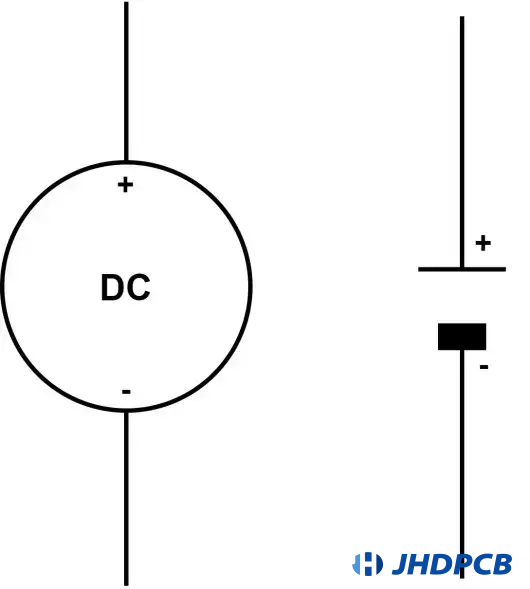
IEC DC Power Circuit Wire Color Codes
The International Electrotechnical Commission (IEC) establishes a set of regulations for electrical wiring conventions. The subsequent table outlines the IEC guidelines pertaining to cables designed for direct current (DC) voltage applications.
| IEC Standard | |||
| Function | Label | Color | |
| Protective earth | PE | Green-Yellow | |
| Two-wire unearthed DC system | |||
| Positive | L+ | Brown | |
| Negative | L- | Grey | |
| Two-wire earthed DC system | |||
| Positive (Negative earthed) circuit | L+ | Brown | |
| Negative (Negative earthed) circuit | M | Blue | |
| Positive (Positive earthed) circuit | M | Blue | |
| Negative (Positive earthed) circuit | L- | Grey | |
| Three-wire earthed DC system | |||
| Positive | L+ | Brown | |
| Mid-wire | M | Blue | |
| Negative | L- | Grey | |
How to measure dc voltage with a multimeter?
Utilize a multimeter for the assessment of direct current (DC) voltage. The underlying principle remains consistent regardless of the DC voltage measurement location. Perform a comparable procedure to check the voltage of a power bank, similar to that employed for a battery.
Please follow these instructions to examine the charge level of a battery:
- Detach the battery from any power tools or chargers. In the case of car batteries, they can be tested in situ after leaving the headlights on for two minutes and subsequently turning them off.
- Insert the black probe into the shared socket.
- Connect the red plug into the jack labeled for DC voltage, VΩ, or V–.
- Position the black connector on the minus (-) terminal of the battery.
- Place the red probe onto the positive terminal.
- Make a record of the measurement indicated on the multimeter.
- First, detach the red probe, followed by disconnecting the black probe.
Pro-tip: In the event that your digital multimeter exhibits a negative reading, interchange the black and red probes to obtain a positive reading. The numerical value should remain the same, but without a negative symbol preceding it. Exercise caution when handling an analog multimeter to avoid interchanging the positive and negative terminals, as this could potentially lead to damage to the device.
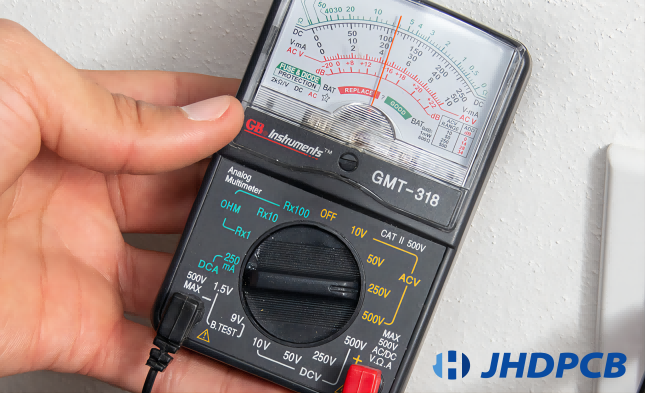
How to calculate DC power?
Using Ohm’s law, you can determine the voltage (V), current (I), resistance (R), and power in a direct current (DC) circuit.
The equation for voltage is V = I * R.
Let’s apply this concept to an example calculation:
Given: I = 0.5 amps-DC (or 500 milliamps DC) and R = 100 ohms.
V = I * R = 0.5 * 100 = 50 volts, or 50 VDC
To calculate power when both current and voltage are known, we use the equation P = V * I:
From step 2: P = 50 V * 0.5 A = 25 watts
To express DC voltage in kilovolts (KVDC), divide it by 1,000:
17,250 VDC / 1,000 = 17.25 KVDC
For small voltages, it may be more convenient to express them in millivolts (mVDC) by multiplying by 1,000:
0.03215 VDC * 1,000 = 32.15 mVDC
Symbols
- P = Electrical power (DC)
- V = Voltage (DC)
- I = Current (DC)
Voltage (V): This represents the electric potential or voltage (V) in a direct current (DC) circuit, which is either applied to the circuit or generated within it.
Current (I): This refers to the electric current (I) that is passing through the direct current (DC) electrical circuit.
Power (P): This represents the electrical power produced as a result of the given values for voltage and current in a direct current (DC) electrical circuit.
How to step up dc voltage?
To increase the voltage in a direct current (DC) power system, one can employ a high voltage DC-DC converter, such as a boost converter. The boost converter falls under the category of DC-DC power converters and functions by storing energy within an inductor when the switch is in the closed state and subsequently releasing that stored energy to the output when the switch is open.
This high voltage DC-DC converter efficiently steps up the input voltage to a higher level, enabling the transmission and utilization of high voltage DC power in various applications. Additionally, by cascading multiple boost converters, it is possible to double DC voltage level, providing even higher voltage outputs for specific requirements.
The boost converter comprises a minimum of two semiconductor switches (diode/transistor) and one energy storage component (inductor/capacitor). When the switch is in the closed position, the input voltage is applied across the inductor, leading to the accumulation of energy within its magnetic field. Upon opening the switch, the energy stored in the inductor is discharged towards the output, thereby yielding an output voltage higher than the input voltage.
To minimize fluctuations and noise in the output, filters are frequently employed in boost converters. These filters, typically composed of capacitors or a combination of capacitors and inductors, aid in smoothing out the output voltage and reducing any variations.
It is important to understand that in a boost converter, as the voltage increases, the current decreases to maintain constant power. This correlation adheres to the principle of power conservation.
In alternating current (AC) power systems, transformers are commonly utilized for voltage step-up or step-down purposes. However, transformers rely on the changing magnetic field generated by AC to induce voltage in the secondary winding. Since direct current (DC) power systems have a constant flow of current, there is no altering magnetic field to induce voltage in a transformer. Therefore, in DC power systems, boost converters are essential for voltage step-up operations, while buck converters are employed for voltage step-down operations.
How to step down dc voltage?
Transformers, commonly utilized for voltage reduction, operate with AC (alternating current) voltages rather than DC (direct current) voltages. To decrease a DC voltage, alternative methods must be employed. There are multiple alternatives to consider, but the two simplest techniques include the “resistor-based series voltage reduction” and the “voltage division circuit.” For simplicity, we will employ a 12-volt battery as the DC power source and a 6-volt, 6-watt Halogen seal beam lamp as the load.
Utilize a series voltage dropping resistor:
Step 1
Apply Ohm’s Law to ascertain the “load current” in amperes (load amps = watts/volts). Load current = 6/6 = 1 ampere.
Step 2
Compute the resistance of the “series voltage dropping resistor.” R = E/I, where: R = resistance in ohms, E = voltage, and I = load current in amperes. Therefore, R = 6/1 = 6 ohms.
Step 3
Calculate the power dissipation rating of the power resistor and incorporate a 25 percent safety margin. P = 1.25(I)(E) = 1.25(1)(6) = 7.5 watts. Opt for the nearest standard resistor wattage rating value, which is 10 watts
Step 4
Attach one end of the voltage dropping resistor to the negative battery terminal using a jumper. Connect the other end of the voltage dropping resistor to one of the terminals on the sealed beam lamp with a jumper. Finalize the circuit by linking the other terminal on the lamp to the positive battery terminal. The light will then illuminate.
Step 5
Measure the circuit voltages. Position the voltmeter probes across the resistor. The meter will exhibit 6 volts. Place the probes across the terminals on the lamp. The meter will indicate 6 volts.
Constructing a voltage divider using two fixed value resistors (R1 and R2):
Step 1
Compute the “bleeder current.” The bleeder current refers to the current flowing in the voltage divider network, which does not pass through the load. When designing a voltage divider, it is generally recommended to make the bleeder current 10 percent of the load current. In this case, the load current is 1 amp, so the bleeder current equals 0.1 amps. Calculate the total resistance for the voltage divider network by dividing the source voltage by the bleeder current. R total = E source/I bleeder = 12/0.1 = 120 ohms.
Step 2
Calculate the electrical current passing through R1. This current will be the combination of the bleeder current and the load current. I R1 = I bleeder + I load = 0.1 + 1.0 = 1.1 amps. Calculate the resistance value of R1 by dividing the voltage across R1 by the current flowing through it. R1 = 6/1.1 = 5.4545 ohms. Round down to 5 ohms to provide approximately 5.995 volts to the load, which is close enough to the load’s 6-volt rating. Calculate the power rating for R1. P = 1.25(1.1)(6) = 8.25 watts. Use the next closest value, which is 10 watts.
Step 3
Calculate the resistance of R2 by subtracting R1 from the total resistance (RT). R2 = RT – R1 = 120 – 5.45 = 114.55 ohms. Round up to 115 ohms. Calculate the power dissipation rating for R2. P = 1.25(0.1)(6) = 0.75 watts, so a 1-watt rating should suffice.
Step 4
Connect R1 and R2 in series using a jumper wire. Attach this sequential circuit between the battery’s positive and negative terminals. Use two additional jumper wires to connect the sealed beam lamp across R1. The lamp will then illuminate.
Step 5
Measure the voltage across both resistors using a digital multimeter (DMM), which should read 12 volts. Measure the voltage across either R1 or R2 with the voltmeter, which should read 6.0 volts when the load is connected.
Application of Direct Current
Direct current (DC) is utilized in a wide range of areas owing to its distinctive properties and benefits. Here are several popular implementations of direct current:
- Electronics: Direct current (DC) finds widespread application in various electronic devices, including but not limited to computers, smartphones, televisions, and radios. Integrated circuits and digital components require consistent and regulated DC power to function properly.
- Powering Small Devices: Numerous battery-operated devices, including torches, remote controls, and portable music players, operate on DC power. The battery supplies uninterrupted current to these devices, providing the necessary energy.
- Electric Vehicles: Electric vehicles (EVs) rely on DC power stored in batteries for propulsion and operation of various systems. The onboard charging system transforms the alternating current (AC) obtained from charging stations into direct current (DC) energy for replenishing the battery of the vehicle.
- Renewable Energy Systems: Direct current plays a pivotal role in renewable energy systems like solar photovoltaic (PV) and wind turbines. Solar panels and wind turbines generate DC electricity, which is subsequently converted into AC using inverters for integration with the grid or powering off-grid applications.
- Telecommunications: DC power is used in telecommunications networks to provide backup power to critical infrastructure, such as cell towers, data centers, and communication equipment. Batteries connected to DC power systems ensure uninterrupted power supply during outages.
- Transportation: DC traction systems are widely employed in electric trains, trams, and subway systems. DC motors offer efficient and controllable acceleration, making them suitable for rail transportation.
- Electroplating: In the procedures of electroplating, direct current (DC) is employed to apply a metal coating onto a substrate. Direct current helps control the deposition rate and provides the necessary energy for the electrochemical reactions involved.
- Joining: Joining techniques frequently employ direct current (DC) electricity to establish an electrical discharge between the joining electrode and the workpiece. The thermal energy produced by the discharge liquefies the metals, allowing them to amalgamate.
- Research and Testing: DC power supplies are commonly used in laboratory settings for research, testing, and calibration purposes. They provide a stable and precise power source for various experiments and equipment.
- Medical Applications: Direct current is employed in medical devices such as pacemakers, defibrillators, electrocautery tools, and certain diagnostic equipment. These devices rely on DC power for accurate and controlled operation.
These are merely a handful of instances that illustrate the utilization of direct current (DC) across diverse industries and applications. The versatility and dependability of DC render it indispensable in a plethora of technological advancements and the everyday gadgets that we employ.
The characteristics of DC.
Direct current (DC) presents numerous benefits and drawbacks when compared to alternating current (AC). Here are the primary strengths of DC:
Advantages of DC:
- Efficiency: DC systems generally exhibit superior efficiency in comparison to AC systems. This is attributable to reduced energy losses caused by factors such as reactive power, skin effect, and voltage drop.
- Battery Storage: DC represents the standard electricity format for batteries. It enables effective energy retention and facilitates the harnessing of sustainable energy sources such as solar and wind energy.
- Stability: DC power ensures a stable and constant voltage or current, which proves optimal for delicate electronic devices and equipment. It minimizes the likelihood of voltage fluctuations and interference from electrical noise.
- Control: Direct current provides superior control and regulation capabilities when compared to alternating current. It allows for precise fine-tuning of voltage and current levels, making it well-suited for applications that require accurate control.
- Safety: DC power poses a lower risk of electric shock in contrast to AC power. With appropriate insulation and grounding, DC systems can offer enhanced safety during low-voltage operations.
However, DC also presents certain drawbacks:
Disadvantages of DC:
- Transmission Limitations: Transmitting DC power over long distances is less efficient compared to AC transmission. AC power can be readily adjusted using transformers for efficient long-distance transmission, while DC requires intricate conversion systems.
- Cost: Establishing infrastructure for DC power distribution generally entails higher costs and complexity than AC systems. This includes the need for power electronic converters, inverters, and specialized equipment.
- Limited Availability: Unlike AC power, which is easily accessible from utility grids, DC power sources necessitate specific setups such as batteries, solar panels, or generators. This limited availability hampers widespread utilization in certain regions.
- Suitability Problems: Numerous current devices and appliances are engineered to function with alternating current (AC) electricity. Adapting these devices to function on DC power may call for additional conversion equipment or modifications.
- Maintenance Challenges: DC systems might require more frequent maintenance due to the involvement of complex electronic components like inverters and converters. Troubleshooting and repairing DC systems can be more intricate and time-consuming.
It is important to acknowledge that the merits and drawbacks of DC and AC rely on the particular application and needs. While DC presents certain distinct advantages, AC continues to be the prevailing mode of electrical power transmission and distribution worldwide owing to its effectiveness and compatibility with current infrastructure.
What is the difference between ac and dc voltage?
There exist two separate categories of electric energy: continuous current (CC) and oscillating current (OC). Both varieties of electricity play a crucial role in the functioning of electrical devices. However, these energy forms vary in their utilization, signals, mode, and other aspects.
The notable distinction between AC and DC power is illustrated in the following comparative chart:
| Basis for Comparison | AC Voltage | DC Voltage |
|---|---|---|
| Definition | The AC voltage serves as the driving factor behind the oscillating flow of current between two points. | The DC voltage generates the unidirectional flow of current between two points. |
| Iconic Depiction | 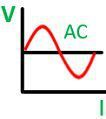 | 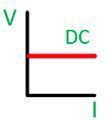 |
| Frequency | Varies by nation. | Zero |
| Coefficient of Efficiency | Ranges from 0 to 1. | 0 |
| Direction | Alters | Remains Consistent |
| Orientation | Fluctuates | Stays unchanged |
| Derived from | Dynamo | Unit or Accumulator |
| Effectiveness | Elevated | Poor |
| Inert Attribute | Reactance | Conductance |
| Magnitude | Possess | Lack |
| Transformation | Through utilization of inverter. | Through utilization of rectifier. |
| Converter | Necessitates for transfer. | Not necessitates. |
| Line and Ground | Posess | Do not possess |
| Advantages | Easy to measure. | Easily amplify |
| Electron motion | The electrons oscillate and change their direction periodically in an alternating manner. | The electrons undeniably move in a consistent direction without any change. |
| Category | Sine, Square, Trapezoid, and Triangle signal. | DC is often categorized as pulsating and pure DC. |
| The load type | Conversely, AC voltage interfaces with different categories of loads, namely capacitive, inductive, and resistive loads. | It exclusively interfaces with the resistive load category. |
| Hazardous | When managed irresponsibly, it is unquestionably perilous. | DC electrical power poses a greater danger in comparison to AC power with a similar rating. |
| Application | Conversely, AC is utilized by domestic and industrial devices such as dishwashers, refrigerators, and toasters. | Mobile phones, LCD televisions, portable lights, electric and hybrid cars, and so on. |
| Source | Conversely, it operates on an alternating current (AC) circuit and generator. | It utilizes both a direct current (DC) battery and a power generator. |
| Electric power transportation | It can also be transported through high-voltage direct current (HVDC) systems. | In terms of power or electrical supply, the most advanced transmission method is through high-voltage direct current (HVDC) systems. Furthermore, in this system, direct current (DC) exhibits minimal voltage loss. |
| Types of Sweeps | The AC frequency analysis is specifically formulated to compute the small-signal voltage reaction of a circuit. | The current source mode typically calculates the operating point of specified power sources in predefined increments across a range of voltage values. Moreover, the DC sweep functionality is compatible with any source that has a variable DC component. |
| Scan type | The usual operation of this scanning method involves conducting a sample cycle at the designated speed to determine timing conformance. | The scanning rate ranges from 100 milliseconds to 10,000 seconds. Furthermore, it is capable of operating with either a ramp or triangle waveform. |
Having a clear comprehension of the disparity between alternating current (AC) and direct current (DC) voltage is essential for identifying suitable applications and designing electrical systems accordingly.
How to convert from ac to dc voltage?
Rectifiers
Rectification refers to the transformation of an alternating current (AC) power source into a direct current (DC) power source. Rectifiers are devices designed to convert AC supply into DC supply. Fundamentally, this conversion process can be subdivided into four sequential stages:
1.Voltage reduction
Typically, an alternating current (AC) power source operates at a high voltage level due to its efficient transmission with minimal losses. Nonetheless, our devices require a lower voltage supply. To achieve this, a step-down transformer is employed. In step-down transformers, the primary coil consists of a greater number of turns compared to the secondary coil.
2.AC to DC conversion
Following the voltage reduction process, alternating current (AC) is transformed into direct current (DC) through the use of rectifiers to convert DC voltage. A full bridge rectifier can be employed for this purpose. This device utilizes four diodes that operate in a forward bias and not in a reverse bias. In the positive phase, two diodes are operational, whereas in the negative phase, the other two diodes are activated. In this manner, the AC supply is rectified into a DC supply to convert DC voltage. The image below depicts a full-bridge rectifier circuit utilized for converting AC to DC.
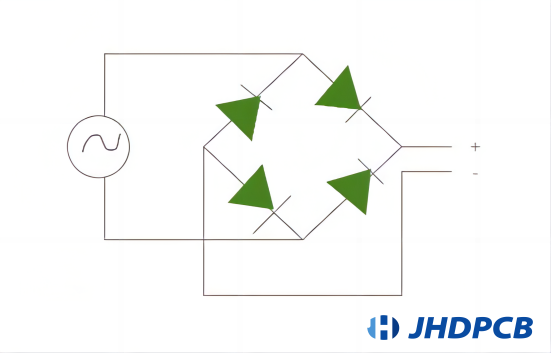
3.Refining DC waveforms
The DC waveforms produced during the previous stage may exhibit pulsating characteristics and fluctuations, lacking pure DC waveforms. Capacitors are utilized to address this issue. Capacitors act as devices to store energy when the input voltage rises from zero to its peak value. The energy stored in the capacitor can be discharged when the input voltage decreases back to zero. This process effectively smoothens the waveforms to a considerable extent.
4.Stabilizing DC voltage
Ultimately, the DC voltage is adjusted to a predetermined and constant value by employing a voltage regulator integrated circuit (IC). The voltage regulator IC is comprised of an integrated electronic circuit that performs the final conversion of our DC supply to the desired voltage level. For instance, the 7805 Voltage Regulator IC is utilized to convert the DC supply to a fixed 5V output, while the 7809 Voltage Regulator IC is used to convert the DC supply to a fixed 9V output.
Rotary Converter
A rotary converter is essentially a mechanical device that functions as a rectifier, inverter, or frequency converter. It harnesses kinetic energy to transform alternating current (AC) into direct current (DC). The rotary converter comprises of two apparatuses interconnected by means of a solitary rotating armature and a collection of field coils. It encompasses a DC generator (dynamo) with a uniformly spaced arrangement of slip rings integrated into its rotor windings. The AC current undergoes rectification through a commutator, from which direct current is derived from the rotor. The energized coils rotate and stimulate the stationary field windings, thereby generating direct current. The rotary converter functions as a fusion of a generator and a mechanical rectifier. Furthermore, it functions as an alternator due to the presence of AC slip rings.
Switched-mode power supply (SMPS)
An SMPS, also known as a switching power supply, is an electronic circuit that incorporates switching elements like MOSFETs. These devices are rapidly switched on and off at high frequencies (measured in kilohertz). Energy storage elements like inductors or capacitors are utilized to supply power during the intervals when the switching device is non-conductive.These components are interconnected using a sophisticated circuit configuration and are utilized for the conversion of alternating current (AC) to direct current (DC).
Applications of AC to DC converters
- AC to DC converters are applied in a wide range of household devices, including but not limited to vacuum cleaners, washing machines, and refrigerators.
- Devices like computers, televisions, cell phone chargers, and others operate on DC power. Thus, AC-to-DC converters play a vital role in powering these devices.
- AC to DC converters are also employed in medical equipment, factory automation, and systems for process control.
- Notable uses of AC to DC converters extend to renewable energy management, test and measurement instruments, aerospace technologies, and transportation systems, among others.
In conclusion, direct current (DC) voltage is a constant voltage that flows in a single direction in a circuit. Devices like batteries, solar panels, and generators are commonly employed for generating DC voltage.
As a professional PCB manufacturer, JHDPCB has advanced equipment and technology to provide you with high-quality DC circuit board products. Our team possesses a wealth of experience and is dedicated to fulfilling customer demands while delivering optimal solutions. Whether you need a simple single-layer DC circuit board or a complex multi-layer DC circuit board, we can meet your needs.
Our manufacturing process for DC circuit boards meticulously complies with global standards and quality control protocols to guarantee the dependability and consistency of our products. Whether you are in the consumer electronics, industrial equipment, or communication industry, we can provide you with customized DC circuit board solutions.
Should you require any assistance with DC circuit board manufacturing and assembly services, we encourage you to reach out to us without hesitation. We are fully committed to delivering exceptional service and working together with you towards mutual achievement.
